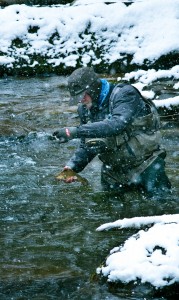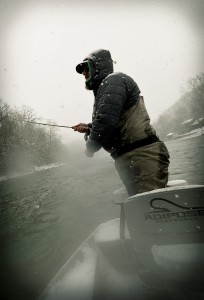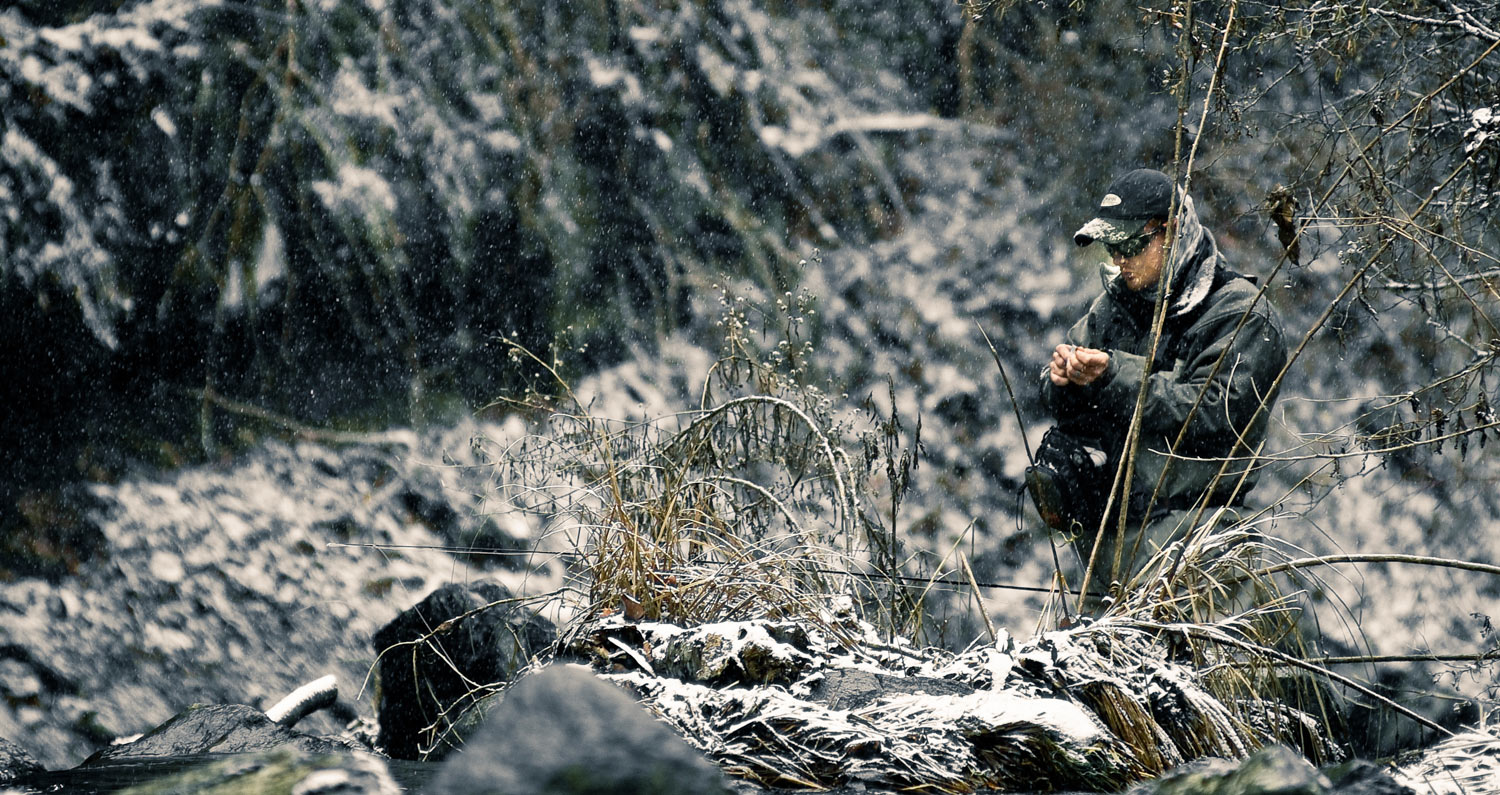By Kyle Wilkinson
Being prepared for a day of winter fishing means more than having a box of the right flies.
I got an email earlier today from a customer who had just gotten back from the river. He had attempted to fish the South Platte however, after several hours of trying to cast between floating icebergs and slush, he decided to wave the white flag and head home. His question was to know how to predict these sort of conditions ahead of time- before making the hour plus drive to find an unfishable river.
The South Platte, like virtually every other tailwater around the country, is well known to be a year-round fishery. With that said, there are still a few other factors that need to be considered when planning a winter outing. Following these 5 steps are just as important as your fly selection if having a comfortable and successful day on the water during winter is your goal.
Nighttime Temperatures. Everyone loves to pay attention to the daytime temps you’re likely (or more like keeping the fingers crossed) to experience during your day of winter fishing. A sunny, 40 degree day during January can feel like a heat wave, particularly if you’re coming off a nasty cold stretch leading up to it. And while pleasant daytime temps are something no one will complain about, the nighttime temperatures in the days leading up to your trip are just as important to pay attention to. Given the fact that it’s winter, fishing a tailwater is always going to be your best bet. If you see nighttime temps are hovering around freezing, plan on seeing the majority of the river open. On the other hand, if your day on the water is immediately following a especially cold stretch- i.e. single digits (or lower) at night, followed by sub 32 degree days, then plan on the situation mentioned in the first paragraph to be what you encounter. Thankfully, given the wonderful nature of tailwaters, the remedy to avoid fishing in a “Slushy” is to just plan on fishing closer to the dam. The water should remain warm enough–particularly within the first mile below the outlets– to remain relatively ice free compared to the lower stretches.
 Layer Properly. I know this seems like common sense, but it’s something I see a lot of people do wrong. First off, quit wearing jeans under your waders (even if you do wear some long johns underneath them). Jeans are extremely hard on the interior of your waders, particularly the rivets around the pockets. As a matter of fact, I was talking to an employee at Simms the other day and he said when a pair of waders comes in for repair, they can instantly tell if the person has been wearing jeans under them based off the damage to the internal shell. Additionally, jeans are made of cotton and there is no room for this on the water– particularly in the winter. Cotton does not breathe and if it becomes wet–through perspiration or an untimely step across a slick rock– is going to retain the moisture, thus making you even colder. The entirety of your layering system should consist of wool or synthetic materials, which will wick away any excess moisture, keeping you much warmer and more comfortable.
Layer Properly. I know this seems like common sense, but it’s something I see a lot of people do wrong. First off, quit wearing jeans under your waders (even if you do wear some long johns underneath them). Jeans are extremely hard on the interior of your waders, particularly the rivets around the pockets. As a matter of fact, I was talking to an employee at Simms the other day and he said when a pair of waders comes in for repair, they can instantly tell if the person has been wearing jeans under them based off the damage to the internal shell. Additionally, jeans are made of cotton and there is no room for this on the water– particularly in the winter. Cotton does not breathe and if it becomes wet–through perspiration or an untimely step across a slick rock– is going to retain the moisture, thus making you even colder. The entirety of your layering system should consist of wool or synthetic materials, which will wick away any excess moisture, keeping you much warmer and more comfortable.
Wear One Pair Of Socks. I’m sure a few of you reading this will disagree, but don’t wear more than one pair of socks. I know it makes sense on a surface level that if ‘one pair of socks is warm, two should be warmer’, but in reality the exact opposite is true and here’s why. The second pair of socks you put on over the first is going to compress the first pair tighter to your feet. This extra pressure is going to cut down on blood circulation to your feet, which will make them colder. With the research and technology that goes into clothing these days, there are plenty of fantastic options for socks out there made specifically for extremely cold conditions.
Grub It Up and Drink It Down. Many people I talk to claim they don’t eat when they’re fishing. The reasons for this are many and range from ‘forgetting to’ to not feeling hungry while fishing, to not wanting to waste a single moment on the water, etc, etc. When it’s cold outside your body is going to burn more calories in an attempt to stay warm– particularly when you start shivering. Making sure to bring along some high calorie snacks such as trail mix or granola bars will ensure your blood sugar levels don’t drop, making you weaker and colder. Additionally, drink lots of water. Staying hydrated is another easy way to ensure your body is functioning on all 8 cylinders. Side note: drinking alcohol should be avoided if you’re really worried about the cold. I know the nip of bourbon tastes damn good when you’re bundled up on the river, but the fact is alcohol dehydrates your body which is never going to be the best way to stay warm.
 Focus On The Core And Work Your Way Up. In my opinion, keeping the core warm is what it’s all about. My typical layering system for extremely cold days is a wool long underwear top, followed by a fleece quarter-zip pullover, followed by a puffy Primaloft or down vest, followed by an exterior Gore-Tex shell. I’ll also wear a buff (either synthetic or wool) as well. Even if it’s not pulled up on my face, the buff will help seal in heat around your neck that may be trying to escape. I think wearing the buff pulled up on your face– even if it’s not sunny– can help keep you warmer in the winter by preventing your skin from being as directly exposed to the cold and wind. Lastly, I always top my layering off with a good stocking cap to keep heat from escaping through my head.
Focus On The Core And Work Your Way Up. In my opinion, keeping the core warm is what it’s all about. My typical layering system for extremely cold days is a wool long underwear top, followed by a fleece quarter-zip pullover, followed by a puffy Primaloft or down vest, followed by an exterior Gore-Tex shell. I’ll also wear a buff (either synthetic or wool) as well. Even if it’s not pulled up on my face, the buff will help seal in heat around your neck that may be trying to escape. I think wearing the buff pulled up on your face– even if it’s not sunny– can help keep you warmer in the winter by preventing your skin from being as directly exposed to the cold and wind. Lastly, I always top my layering off with a good stocking cap to keep heat from escaping through my head.
When it comes to winter fishing, taking these few extra steps can go a long way in ensuring your mind is able to stay focused on the fish…..and not just on how damn cold you are!
Kyle Wilkinson Gink & Gasoline www.ginkandgasoline.com hookups@ginkandgasoline.com Sign Up For Our Weekly Newsletter!



Thanks for this Kyle. I’ll have to think about the sock thing, but you are spot on about the rest. I fished closer to the Spinney dam on the upper S. Platte at -6 last week and the water was clear. Risers by 11. Fingers were the toughest part, but a couple hand warmers in the pockets did wonders.
Doug,
I think Kyle is spot on about the socks. for many years I would put on several socks and my feet always got cold anyway. These days, (63 yrs old) one pair of quality socks.(I wear the Merino wool one’s from Cabelas) and a good insulated boot is all that’s needed.
Jeff
Do it. I use to wear a think wool sock and my feet always got cold. Since moving to a thinner wool sock my feet are much warmer.
Great post my man, I see too many people really taking their chances out here in these canyons. Jeans in the cold? I thought that was an outdoor no-no 101. I guide and fish all over the south platte, and it is an amazing winter tailwater for sure, but boy has it been cold this year! As for foot warmth and socks, I have a few suggestions. First of all a pair of boots that aren’t too snug are key in the winter, the air gaps around your foot will provide the best insulation. Also, Simms as well as I believe Smartwool make a Silk or poly “liner sock” that is super thin and designed to move moisture off of your foot. When paired with a regular weight wool hiker there is little to no extra bulk, and with a good fitting pair of boots your feet should be happy even on the coldest of days. As for the fingers, winter is a great time to work on your off hand casting. I generally wear a good pair of fingerless mittens and just tuck one hand into a warm pocket until my casting hand is too cold, then switch!
I’ll go with Michael.
I worked for a water utility for years, and the best insulation that I found was silk or poly ultra-lite liners under medium or
ski weight wool sox inside my boots.
It worked well below zero in wet conditions.
Worth. It.
+2
Michael hit the nail on the head. I really dont suffer from cold feet fortunately so I cant testify on liners under your socks but I 100% agree that a pair of boots that “aren’t too snug” are ideal for winter. I wear a half size bigger in winter (Simms Freestone boot). The right fitting boot plus ONE pair of good socks keeps most people warm on fishable winter days IMO.
I do unfortunatlely suffer from cold hands though. My hands seriously freeze. They get so got damn cold its unbelievable. Ive tried everything to keep my hands warm while fishing and snowboarding from the buying most expensive gloves, to kincos, to every brand of hand warmer out there — even that funky Zippo one. Anyway here’s what works for me:
1) Mid level pair of snowboard mittens for both fishing and snowboarding (I cannot fish with any type of glove)
2) Bulk order on Amazon of Hot Handz (They’re pretty gaper but they fucking work like no other)
3) A dish rag to dry your hands when the become wet.
Those three are my rules to live by for cold hands. Great article with today’s weather!
Lower body layering is definitely important too as well as up top. On bottom I usually wear a merino wool or synthetic tight fitting wicking layer underneath a pair of one or two Simms micro-fleece pants depending on how cold the water is. I think a pair of wicking “liner socks” are great under a pair of thick wool socks too. They’re made of a synthetic material to keep the moisture away from your sweaty feet and are very thin, so they don’t add much bulk or constrict your feet. Two pairs of thick socks is asking for trouble, but a pair of liner socks under wool socks is awesome!
edit: Whole size bigger
Hands Base Layer : Try heavy duty surgery gloves. Allows you to keep hands dry. Thin enough to perform any knots and or fly fishing chore. Plus, thin enough to add another warmer layer on top. Can be reused for a few outings.
Getting cold easily (read older) altered my winter clothing. I love and wear silk next to my skin (also been using poly house pants as you suggested) to add layers. On days that I plan to be IN the water most of the day I slip on a puffy pair of ski bibs ($5 from second hand) to give a big transition zone from waders to under layers. ABOUT THOSE EXTRA SOCKS. . .
I figured it out a couple of years ago. Go ahead and wear those socks – just buy yourself a pair of winter wading boots. I wear size 8 for summer/spring season but when it gets cold I put on my winter boots which are 2 whole sizes larger. This gives me plenty of room for plenty of sox and neoprene booty – three pairs of various materials – and there is no compression and/or constriction. I didn’t even have trouble with the larger boot size. After the first couple of strides the body/mind adjusted to the bigger boot just like going up or down stairs with different treads.
I also use a more full sized wader for winter. Mfg. now have a stout/girthy/whopper size for an established height which don’t fit well in the summer but come winter these more expanded waders gives me plenty of room for clothing without any restriction.
I’m hanging out in our towns only BBQ place for those little packets of line cleaner you mentioned.
Thanks for sharing – great stuff
What about my hands? I always feel like that is what gets cold and have yet to find a good pair of gloves that don’t limit my dexterity. Any suggestions?
Also, a thin layer of gauze, with a hand warmer on top secured with a piece of medical tape on your wrist is AWESOME for cold hands. It heats the blood up as it goes through the artery to your fingertips. Combined with gloves this it really helps you stay out for a long time without your hands going numb.
How about fishing the last warm day before a cold front? In the summer the best time for me to catch warm water fish is before a storm because they go crazy eating, is it the same for trout in the winter?
One pair of good quality thick wool socks and roomy boots…also keep another pair of socks warm and dry in the truck and change into them at lunch time. Having extra room in your boots is key. I wear larger boots in extreme cold water and being able to create air space and toe wiggle room makes all the difference…Great article!
Great article…a few suggestions already offered about “pants” options under waders…I am a “jeans” offender…if someone has suggestions of inexpensive alternatives–wool or synthetics?, would appreciate… thanks…
Brad
Any Merino long under ware, I prefer smart wool or 33 Degrees. Over that, fleece wading pants, inside those heavy waders!
Pingback: Tippets: Gear for Saltwater, Winter Fishing Tips | MidCurrent